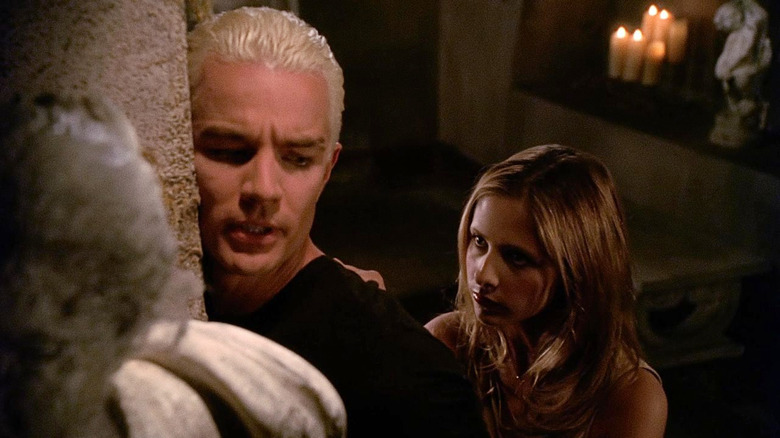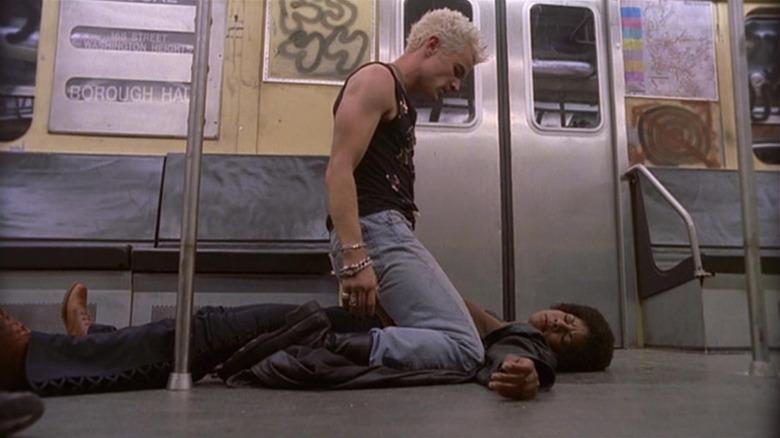One Of The Best Buffy The Vampire Slayer Episodes Includes Nods To Sin City And Reservoir Dogs
In its fifth season, "Buffy the Vampire Slayer" got darker than ever. The surprise death of Joyce Summers (Kristine Sutherland) broke the hearts of fans everywhere and pushed the show into bleaker, more adult territory. By season five's end, Buffy (Sarah Michelle Gellar) herself would be dead, and her resurrection the following season came with unexpected side effects: depression, survivor's guilt, and a strong self-destructive streak.
But before Buffy rose from the grave and Joyce met her own, the hit vampire dramedy was already planting the seeds for the slayer's aching death wish. Most notably, her enemy turned eventual lover Spike (James Marsters) whispered his twisted philosophy on slayers and death into her ear in one of the show's best episodes, the fifth season outing "Fool For Love." One of the show's slickest, sexiest, and most narratively and emotionally complex episodes, "Fool For Love" unearths Spike's backstory, beginning with his youth as a human dandy poet and ending with his ultra-cool — yet ultimately insecure — present-day self.
Spike, Tarantino style
Series co-executive producer Douglas Petrie ("Pushing Daisies," "Daredevil") wrote "Fool For Love," and in the episode's DVD commentary, he revealed that the filmmaking and costuming inspirations for the hour were as wide-ranging as Spike's own bloody history. Petrie notes that the storyline, which unfolds via flashback as Spike shares his own (sometimes glossier) version of it with Buffy, plays out a bit like "Pulp Fiction," with "B-side" scenes that have an "A-side" counterpart in the accompanying "Angel" episode "Darla."
While Petrie says the team used the "Pulp Fiction" reference point in discussions about the two-parter, an even more overt Quentin Tarantino episode came out late in "Fool For Love," when Spike faces off against a badass slayer named Nikki (April Weeden) on an abandoned New York City subway car. In the thrilling and horrifying sequence, the action cross-cuts between Spike's present-day fight with Buffy and his previous battle with Nikki in 1977, which ends with him brutally breaking the slayer's neck — and stealing her trenchcoat.
"This intercutting, by the way, is inspired by (which means ripped off from) 'Reservoir Dogs,'" Petrie noted in the commentary track. "Tim Roth's character tells a story in 'Reservoir Dogs' and you sort of see him narrating the story within the story itself." Spike does the same thing as that film's Mr. Orange, telling Buffy the story even as he's in the middle of it, spinning a lead pipe in his hands even as he polishes up a gruesome story into an anecdote with a lesson. That lesson? That, according to Spike, slayers are "just a little bit in love" with death. It's clearly not true — the two slayers we see Spike kill are fighting until their last gasp — but he's the narrator telling the story, so he gets to make it true.
Does that famous trenchcoat remind you of anyone else?
Petrie mentions several other pop cultural touchstones for the New York City sequence in particular, including "1970s cop movies like 'The French Connection,' 'The Seven-Ups,' and 'Shaft.'" The mesmerizing and violent scene sees a punk-styled Spike — safety pin shirt, acid-wash jeans and all — cement his reputation as a slayer-killer, and collect the final piece of his persona in the form of the black trenchcoat. That, too, was an homage to another great story; Frank Miller's "Sin City" comics.
"There's a guy named Marv who just kills his way to the top of a giant mystery, he's solving a mystery and kills his way up the echelons of this dirty dirty underworld," Petrie explained on the episode commentary. "And every time he kills a guy he takes his coat." The writer says that "one of the ways [the writers] sold this to Joss Whedon" was by pitching the idea of an origin story for Spike's coat. By episode's end, he noted, the villain has all the pieces of his perfectly curated vampire look, from a Cockney accent to his coat to his bleach-blonde hair — yet he's still the pathetic poet inside.
Fool For Love is stylish, complex, and disturbing
"Fool For Love" is one of the best episodes of "Buffy." It's dangerous and sexy at once, revealing more plainly than ever that the characters' death drives and sex drives are two sides of the same coin. It's also both stylishly designed and surprisingly heartless, with Spike's good looks and artful aesthetic countered by his brutish actions against the women he crosses paths with. Decades later, it's clear that series creator Joss Whedon himself had problematic attitudes towards women, and with its near-voiceless, quickly dispatched women of color, "Fool For Love" serves as a microcosm of the show's larger feminist shortcomings.
Yet the episode still pulls off one of the series' most admirably complicated character arcs, elucidating some of Buffy's core fears while showing Spike in both his most empathetic and his most unforgivable moments to date. In the episode commentary, Petrie calls the episode — which he notes he wrote quickly, surviving on Red Bull gifted to him by Marsters and at one point sleeping in a Summer house set bed — one of his favorites, and fans often agree. Homage can be a tricky thing to balance, but "Fool For Love" is much more than the sum of its cinematic parts. If death is the character of Buffy's art, great, surprising filmmaking choices are the show's, and "Fool For Love" is one of its finest works.



